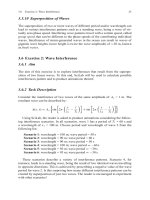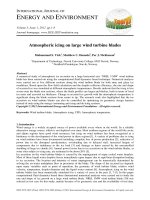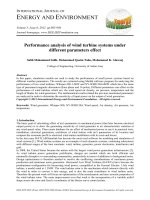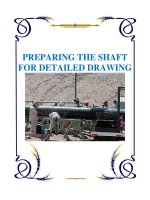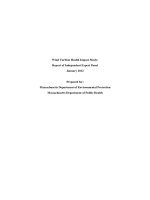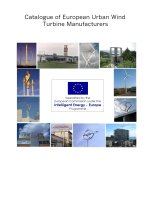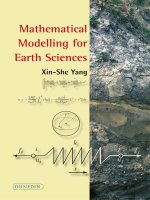Doublyfed induction generator wind turbine modelling for detailed electromagnetic system studies
Bạn đang xem bản rút gọn của tài liệu. Xem và tải ngay bản đầy đủ của tài liệu tại đây (1004.99 KB, 10 trang )
Published in IET Renewable Power Generation
Received on 10th August 2012
Revised on 21st November 2012
Accepted on 17th December 2012
doi: 10.1049/iet-rpg.2012.0222
ISSN 1752-1416
Doubly-fed induction generator wind turbine
modelling for detailed electromagnetic system
studies
Ting Lei, Mike Barnes, Meliksah Ozakturk
Power Conversion Group, University of Manchester, M1 0QD, UK
E-mail:
Abstract: Wind turbine (WT) technology is currently driven by offshore development, which requires more reliable, multi-
megawatt turbines. Models with different levels of detail have been continuously explored but tend to focus either on the
electrical system or the mechanical system. This study presents a 4.5 MW doubly-fed induction generator (DFIG) WT model
with pitch control. The model is developed in a simulation package, which has two control levels, the WT control and the
DFIG control. Both a detailed and a simplified converter model are presented. Mathematical system block diagrams of the
closed-loop control systems are derived and verified against the simulation model. This includes a detailed model of the DC-
link voltage control – a component which is usually only presented in abstract form. Simulation results show that the output
responses from the two models have good agreement. The grid-side converter control with several disturbance inputs has
been evaluated for three cases and its dynamic stiffness affected by operating points are presented. In addition, the relation of
pitch controller bandwidth and torsional oscillation mode has been investigated using a two-mass shaft model. This model
can be employed to evaluate the control scheme, mechanical and electrical dynamics and the fault ride-through capability for
the turbine.
1 Introduction
The trend of future wind turbine (WT) installations moving
offshore is stimulating the need for high reliability and ever
larger WTs in order to minimise cost. Two WT concepts
currently used are considered to be suitable for the
multi-megawatt offshore installations – the doubly-fed
induction generator (DFIG) WT and the permanent magnet
synchronous generator WT [1]. Currently the former with a
capacity up to 5 MW has the largest market share.
Increasingly comprehensive studies need to be carried out
to evaluate the control strategies and system dynamic
behaviour. These studies require accurate models.
DFIG WTs have been investigated for many years [2–10].
In most of these, the converters are simplified as controllable
voltage or current sources with only fundamental frequency
components, which makes it impossible to implement a
detailed study of power converter dynamics. The drive-train
is often treated as a lumped-mass system, which means the
induced torsional oscillations are neglected.
In this paper, a PSCAD/EMTDC-based DFIG WT model
with two control levels is provided. The DFIG control level
involves the rotor-side converter (RSC) control and the
grid-side converter (GSC) control. The WT control level
involves the pitch control and the optimum torque tracking
[4]. Mathematical analysis of each individual control system
is carried out and the mathematical blocks (MB) have been
verified against PSCAD/EMTDC simulation results. Two
converter representations, with and without IGBT switches
are used here, which are referred to as the full switched
model (FSM) and the switch-averaged model (SAM). They
both have been implemented for observing GSC control
performances where the DC-link dynamic is involved. The
latter is used to demonstrate the WT mechanical responses
such as rotor speed and pitch angle to wind speed changes.
Finally, a multi-mass shaft model is added to investigate the
correlation of the pitch mechanism and shaft torsional
modes. This PSCAD/EMTDC m odel can be used to
evaluate the DFIG WT performances under different
operating modes, control schemes and the grid integration
capabilities.
The paper is structured as follows. Section 2 presents the
component modelling and equations. Sections 3 and 4 then
elaborate the DFIG-level and WT-level control systems,
respectively, as well as the mathematical analysis and
simulation results. Section 5 concludes the main results.
2 System modelling
A schematic diagram of the DFIG WT and its overall
control systems are illustrated in Fig. 1. The turbine rotor is
connected to the DFIG through a shaft system. The
generator rotor is fed from the grid through a back-to-back
converter which handles only the slip power (up to 30% of
the rated power).
www.ietdl.org
180 IET Renew. Power Gener., 2013, Vol. 7, Iss. 2, pp. 180–189
&
The Institution of Engineering and Technology 2013 doi: 10.1049/iet-rpg.2012.0222
2.1 Aerodynamic modelling
The aerodynamic model can be described by the equation of
aerodynamic power or torque generated as the wind passes the
turbine blades [11]
P
a
=
r
2
p
R
2
a
C
p
(
l
,
b
)v
3
w
(1)
T
a
=
r
2
p
R
3
a
C
p
(
l
,
b
)
l
v
2
w
(2)
with ρ is the air density (kg/m
3
), R
a
is the radius of the rotor
(m), v
w
is the wind speed upstream the rotor (m/s) and ω
r
is
the rotor speed (rad/s). The power coefficient C
p
is a
function of the tip speed ratio λ and the pitch angle β
(deg.), for which the numerical approximation in [9] is used
l
=
v
r
R
a
v
w
(3)
1
l
i
=
1
l
+ 0. 08
b
−
0.035
b
3
+ 1
(4)
C
p
(
l
,
b
) = 0.22
116
l
i
− 0.4
b
− 5
e
− 12.5/
l
i
()()
(5)
2.2 Induction generator modelling
The DFIG machine equations have been described in [5, 9].
Note that in Fig. 1, the currents are set as outputs from the
stator and rotor. If generation convention is considered, the
set of machine equations can be derived as
v
s
=−R
s
i
s
+
d
c
s
dt
+ j
v
s
c
s
(6)
v
r
=−R
r
i
r
+
d
c
r
dt
+ j
v
s
−
v
r
c
r
(7)
c
s
=−L
s
i
s
− L
m
i
r
(8)
c
r
=−L
r
i
r
− L
m
i
s
(9)
with v is the voltage (kV), R is the resistance (Ω), i is the
current (kA), ω
s
is the synchronous electric speed (rad/s), ψ
is the flux linkage (Wb), L
m
is the mutual inductance
between stator and rotor windings (H ). The subscripts s and
r denote the stator and rotor quantities.
2.3 Back-to-back converter modelling
Two voltage source inverters (VSI) are connected
back-to-back via a DC-link to comprise the converter. This
enables bidirectional power flow. In Fig. 2, the FSM is
presented with all the IGBT switches and a PWM
frequency of 4.5 kHz. This model provides a deeper insight
of the converter dynamics over a short time scale.
In the SAM, the converter is presented as two
current-controlled voltage sources coupled through a
DC-link. The DC-dynamics are based on the power balanc e
between the RSC and GSC, which generates two current
disturbances from the VSIs feeding into the DC-link. The
SAM is suitable for inspecting the mechanical dynamics
over a longer time scale without the disturbance from the
switching noise
2.4 Shaft system modelling
The shaft system has been presented as six, three, two and
lumped-mass models in other research [12], among which
the lumped and two-mass shaft models are often used to
study the electric behaviours of the DFIG. It is suggested in
[11] that for a generator with shaft stiffness lower than 3
pu/el. rad, a two- mass shaft model should be considered.
PSCAD/EMTDC provides the standard models of the
wound rotor induction machine and the multi-mass shaft.
They can be interfaced with WT aerodynamic model and
pitch controller as shown in Fig. 3. The performances of th e
two-mass shaft model are investigated in Section 4. If not
specified, the analysis refers to the lumped shaft model with
a SAM converter in the paper.
The model performances during single or three-phase fault
conditions are presented in Fig. 4, where the stator and rotor
voltages subject to significant changes when the grid voltages
drop to 0 for 100 ms.
Fig. 1 DFIG WT model and its overall control systems
www.ietdl.org
IET Renew. Power Gener., 2013, Vol. 7, Iss. 2, pp. 180–189 181
doi: 10.1049/iet-rpg.2012.0222
&
The Institution of Engineering and Technology 2013
3 DFIG control
The control system has been shown in Fig. 1, in which two
control levels are identi fied based on different bandwidth s.
The DFIG control consists of the RSC control and the GSC
control. The former is used to provide decoupled control of
the active and reactive power while the latter is mainly used
to ensure a constant voltage on the DC-link [5, 7].
3.1 RSC control
Stator-flux orientation is used for the RSC control in which
the stator flux is collinear with the d-axis and the other
rotor quantities are converted to this frame. The equations
of the electric torque and the stator reactive power can be
found in [5], which are modified here using generator
convention,
T
e
=
3
2
L
m
L
ss
c
s
i
r q
(10)
Q
s
=−
3
2
2
√
V
s
L
ss
c
s
−
3
2
2
√
V
s
L
m
L
ss
i
r d
(11)
where V
s
is the stator phase voltage in rms.
Resolving (6)–(9), splitting the rotor voltage in d–
q-components and neglecting the stator flux transients (dψ
s
/
dt = 0) gives
v
r d
∗=−R
r
i
r d
− L
c
di
r d
dt
+
v
slip
L
c
i
r q
(12)
v
∗
r
q
=−R
r
i
r q
− L
c
di
r q
dt
−
v
slip
L
c
i
r d
+
v
slip
L
m
L
ss
c
s
(13)
where
v
slip
=
v
s
−
v
r
, L
c
= L
rr
−
L
2
m
L
ss
The MB diagram of RSC control is depicted in Fig. 5 ,
where the decoupling of d–q control-loops is achieved by
adding the feed-forward compensation after the inner-loop
PI controller. Reactive power control is cascaded with
d-current control loop and electric torque control is
cascaded with q-current control loop. The estimated
quantities are marked by ‘^’ to distinguish them from the
real quantities.
In PSCAD/EMTDC, the DFIG WT is connected to the grid
through a step-up transformer. Parameters used in the model
are tabulated in appendix. The DFIG is set to the speed
control mode with a nominal rotor speed.
Responses from the MB are compared with PSCAD/
EMTDC simulations (‘PCD’), applying the same reference
signals (Ref). In Fig. 6, the plots are resulted from a step
input of Q
∗
s
, T
∗
e
, i
∗
r d
, i
∗
r q
at the four control loops
separately. Note that in the lower plots, the time scale is
smaller since the bandwidth of the current-loop is much
higher than the power loops. It can be observed that the
curves ‘MB’ and ‘PCD’ have a good agreement, indicating
that the mathematical model can describe the software
model accurately for this case.
3.2 GSC control of the DC-link
In GSC control, the q-component controls the DC-link
voltage and the d-component controls the reactive power.
Positive current is considered from the grid to the converter.
Fig. 3 Turbine rotor, two-mass shaft and DFIG model
arrangements in PSCAD/EMTDC
Fig. 2 Two converter models
Upper: FSM, lower: SAM
www.ietdl.org
182 IET Renew. Power Gener., 2013, Vol. 7, Iss. 2, pp. 180–189
&
The Institution of Engineering and Technology 2013 doi: 10.1049/iet-rpg.2012.0222
Thus the voltage equations in the d–q frame are expressed as
v
g d
= R
gsc
i
g d
+
L
gsc
di
g d
dt
−
v
s
L
gsc
i
g q
+ e
g d
(14)
v
g q
= R
gsc
i
g q
+ L
gsc
di
g q
dt
+
v
s
L
gsc
i
g d
+ e
g q
(15)
As shown in Fig. 7, the inner-loop control of the GSC consists
of d–q loops with similar structure. The DC control loop
Fig. 4 Model performances under fault conditions
Left: single-phase fault, right: three-phase fault
Fig. 5 Decoupled control block diagrams of the RSC
a Inner-loop control system
b Outer-loop control system
www.ietdl.org
IET Renew. Power Gener., 2013, Vol. 7, Iss. 2, pp. 180–189 183
doi: 10.1049/iet-rpg.2012.0222
&
The Institution of Engineering and Technology 2013
should be cascaded with q-current control loop, the small
signal model of which will be illustrated in the following
paragraphs.
Aligning the grid voltage to the q-axis (v
g_d
= 0) and
applying power invariant principle to the DC and ac points.
P
c
=
3
2
v
g q
i
g q
= V
dc
i
dc g
= V
dc
i
dc r
(16)
The dynamics equation of capacitor (Fig. 2) can be
described as
C
dV
dc
dt
= i
dc g
+ i
dc r
(17)
Combining (16) into (17) and eliminating term i
dc_g
dV
dc
dt
=
i
dc r
C
+
3v
g q
i
g q
2CV
dc
(18)
Taking partial derivatives of all variables
D
˙
V
dc
=
1
C
Di
dc r
+
3
2C
K
V
Di
g q
+
3
2C
K
G
Dv
g q
−
3
2C
K
V
K
G
DV
dc
(19)
K
V
=
V
g q0
V
dc0
and K
G
=
i
g q0
V
dc0
For steady state
V
dc0
i
dc r0
=−1.5v
g q0
i
g q0
(20)
The power change of the converter is then
DP
c
= V
dc0
Di
dc r
+ DV
dc
i
dc r0
= V
dc0
Di
dc r
− 1.5K
V
K
G
DV
dc
(21)
Fig. 6 Mathematical verification of the RSC control
Upper: outer-loop step response, lower: inner-loop step response
Fig. 7 GSC control block diagrams
Upper: current control loops, lower: small signal model of DC-link control loop
www.ietdl.org
184 IET Renew. Power Gener., 2013, Vol. 7, Iss. 2, pp. 180–189
&
The Institution of Engineering and Technology 2013 doi: 10.1049/iet-rpg.2012.0222
Equation (19) is the small signal model of DC-link. The
subscript ‘0’ denotes a particular operating point. From the
equation, DC-voltage dynamics are affected by several
components: the first two terms are the injected currents at
the DC-link, which will charge or discharge the capacitor;
the last two terms reflect the impact of grid voltage and
DC-voltage changes. In the closed-loop control system,
[Fig. 7 and (19)], the first and third terms can be treated as
external disturbances that cause the change of DC-voltage,
while the second term is the controlled current obtained
from the negative feed-back loop, trying to return
DC-voltage to its operating point. On the other hand, the
first and last terms constitute the converter power change,
as shown in (21). With K
G
being negative, the last term is
actually a positive feedback term that counteracts with the
controlling term, introducing an energy buffer effect.
The DC-control loop has been analysed for three different
cases
A. DC voltage step change.
B. Electric torque (power) step change.
C. Grid voltage drop with 80% remaining voltage.
Case A: Step responses of DC-loop and q-current loop are
shown in Fig. 8. In the plots of DC voltage output responses,
there are two from software simulations, that is, SAM and
FSM and the others are from MB diagrams of varying
complexity. In an order of complexity, these include a
simplified MB that ignores the disturbance feedback term
1.5K
V
K
G
ΔV
dc
, full MBs that consider this feedback term
and then additionally disturbance-terms Δi
dc_r
, Δv
g_q
,
respectively.
The plots of SAM and FSM show that the mean value of
the FSM matches with the SAM. PWM switching is
presented in the current waveform but not apparent in the
DC-voltage waveform because of the smoothing effect. All
the plots from MBs of DC-voltage control can match with
the software simulations except the MB_full. Since there is
no change in the converter (ΔP
c
= 0), the terms ΔV
dc
and
Δi
dc_r
will counteract each other and must be considered
together in this case, as shown in (21). The effect of
Δv
g_q
can be ignored if the grid is assumed to be stiff.
Case B and C: The DC-voltage responses to a Te-step and
grid voltage sag are shown in the lower two plots of Fig. 9.In
both cases, the DC reference value is set to be constant. The
disturbance signal i
dc_r
is the main factor that causes the output
DC-voltage change, which is illustrated in the upper plots. It
can be observed that the mean value of FSM is lower than the
SAM because of the switching losses in the IGBTs. The
contributions of two other disturbance inputs are evaluated
as shown in the lower plots. Three curves from MBs are
shown, which are the MB with all the three disturbance
terms, the one neglecting the term ΔV
dc
and the one
neglecting the term Δv
g_q
. In case B, the MB response will
slightly deviate from the software simulation if ΔV
dc
is not
considered, which plays a more important role than Δv
g_q
in
the DC-dynamics. However, the term Δv
g_q
shows more
Fig. 8 Mathematical verification of the GSC control
Upper: case A – DC-loop step response, lower: current-loop step response
Fig. 9 DC-control disturbance factor analyses for different cases
Left: case B – Te steps from 1.2 to 1.3 pu, right: case C – Grid voltage drops to 80% of nominal value
www.ietdl.org
IET Renew. Power Gener., 2013, Vol. 7, Iss. 2, pp. 180–189 185
doi: 10.1049/iet-rpg.2012.0222
&
The Institution of Engineering and Technology 2013
impact in case C, because of significant grid voltage
oscillations.
In normal WT operating condition, case B is the most
common situation, where the reference electric torque or
power changes because of a wind speed chang e. The grid
disturbance-term Δv
g_q
can be ignored. Now the dynamic
stiffness (DS) [13] of DC-link system can be evaluated for
varying operating points. This describes the resistance of
the system to a certain disturbance. Considering only the
key disturbance input Δi
dc_r
, resulting from the change of
input power ΔP
DS =
DP
DV
dc
=
V
dc0
Di
dc r
DV
dc
= V
dc0
Cs + 1.5v
g q0
K
G
+ K
P
+
1.5v
g q0
K
i
s
(22)
Fig. 10 illustrates the DS when varying two parameters’
operating points, V
dc0
and v
g_q0
, respectively, both of which
are changed from 0.7 to 1.3 times of their nominal values.
The DS is only sensitive to V
dc0
for higher frequencies
because of the first term in (22) and it is sensitive to v
g_q0
for middle and low frequencies because of the other two
terms. As is shown in the figure, the higher the DC-voltage
or the grid voltage is, the higher the system DS will be.
Software simulations have been presented in Fig. 11, where
the DS of the system has been evaluated for three different
V
dc0
and the electric torque is oscillating at 150 Hz with
0.2 pu amplitude.
4 WT control
4.1 Controller development
For the WT control, the system measures the rotor speed and
uses it to generate references both to the pitch system of the
WT and to the DFIG control level (Fig. 1). There are two
different control algorithms for this control level. At lower
wind speeds, the pitch angle remains at the optimum value
(0 degrees) and the optimum torque will be tracked
according to a pre-defined curve [11]
T
opt
g
= K
opt
v
2
r
(23)
At higher wind speeds, the pitch control is activated to
remove excessive power extracted from wind. The two
control modes sometimes work together to regulate the WT
in the high wind region [4, 12, 14]. The model presented
here considers the case where the two controllers operate
independently for their respective regions. A non-linear
transfer function is employed to generate the torque-speed
look-up table.
The pitch controller with full-non-linear plant model is
illustrated as in Fig. 12a. The actuator introduces a lag
between the actual pitch angle and the commanded pitch
from the PI controller. This controller is designed with a
bandwidth of one-magnitude-order smaller than the electric
torque control loop. The actuator time constant is τ = 0.2 s.
J
t
is the total rotational inertia. The wind speed v
w
acts as
the external disturbance experienced by turbine rotor and
the generator torque T
g
is treated as an internal disturbance
signal on the shaft system and it is fixed at the rated value
for the higher wind speed region.
The system model should be linearised in order to evaluate
its control performance. The linearisation process of different
mass systems has been performed in [15] and this
methodology is applied in [16] to design the PI controller.
Here the method is extended to lower wind speed region
and will be justified by software simu lations.
At a particular operating point ω
r0
, β
0
, v
w0
, the aerodynamic
torque can be expressed as
T
a
= T
a
v
r0
,
u
0
, v
w0
+
g
D
v
r
+
z
D
b
+
h
Dv
w
(24)
Fig. 10 DS at different operating points
Fig. 11 Software simulation of DC-link DS in response to Te
oscillations
www.ietdl.org
186 IET Renew. Power Gener., 2013, Vol. 7, Iss. 2, pp. 180–189
&
The Institution of Engineering and Technology 2013 doi: 10.1049/iet-rpg.2012.0222
where
g
=
∂T
a
∂
v
r
,
z
=
∂T
a
∂
b
,
h
=
∂T
a
∂v
w
The rotor dynamics can be described as
J
t
d
v
r
dt
= T
a
− T
g
(25)
For the higher wind speed region T
g
= T
a0
, therefore
D ˙
v
r
= A D
v
r
+ BD
b
+ B
d
Dv
w
(26)
where A = γ/J
t
, B = ζ/J
t
,C=η/J
t
,
For the lower wind speed region
T
g
= T
g0
+ 2K
opt
v
r0
△
v
r
(27)
where T
g0
= T
a0
, eliminating the pitch controller
D ˙
v
r
= (A − C)D
v
r
+ B
d
Dv
w
(28)
with C = 2K
opt
ω
r_0
/J
These two linear models are depicted in Figs. 12b and c.
For the WT-level control simulation, the induction machine
should be held in torque control mode after the initial
transient to interface with the aerodynamic model. The
system responses at two operating points (op) are shown in
Fig. 13, where
Op1: v
w0
= 15 m/s, ω
r0
= 1.2 pu, β = 10°
Op2: v
w0
= 9 m/s, ω
r0
= 0.78 pu, β =0°
On the left plots, as wind rises, the pitch angle increases in
order to maintain the rotor speed within the threshold (denoted
as ‘Thr’). On the right plots, the pitch angle is maintained at 0
degrees despite of the wind speed change. The rotor speed
increases proportionally with the wind speed, to maintain the
optimum tip-speed ratio. The very low response is because
of the large system inertia. In both cases, the results from
‘PCD’ and ‘MB’ match very well. With the lumped-mass
shaft model, no torsional oscillations are presented even
though the pitch controller is relatively fast.
Fig. 12 WT pitch control mechanism
a Pitch control with full-non-linear plant model
b Linearised control model for higher wind speed region
c Linearised control model for lower wind speed region
Fig. 13 Mathematical verification of the WT-level control
left: 0.5 m/s v
w
step at op 1, right: 0.5 m/s v
w
step at op 2
www.ietdl.org
IET Renew. Power Gener., 2013, Vol. 7, Iss. 2, pp. 180–189 187
doi: 10.1049/iet-rpg.2012.0222
&
The Institution of Engineering and Technology 2013
4.2 Controller coordination
To illustrate the relation of pitch controller bandwidth region
and the turbine torsional mode, the responses of a two-mass
WT model to a wind step is simulated for different pitch
controller bandwidths. Results are obtained by stepping the
wind speed from 13 to 14 m/s, as shown in Fig. 14.
Significant mechanical oscillations are presented in the
rotor speed and pitch angle, which are known as torsional
oscillations. The torsional frequency of the WT can be
calculated from [11]
f
T
=
1
2
p
K
s
v
0
(H
turbine
+ H
generator
)
2H
turbine
H
generator
= 2.55 Hz (29)
where K
s
is the shaft stiffness (pu/el. rad), ω
0
is the
synchronous electric speed (rad/s), H is the moment of
inertia (s).
In Fig. 14, lower pitch bandwidth can produce smoother but
slower response and can result in longer over speed. Torsional
oscillations occur as the pitch bandwidth approaches 0.2 Hz,
where the controller bandwidth begins to interfer the shaft
natural frequency. The responses will become unstable if a
Fig. 14 Torsional oscillations observed for a two-mass drive-train
system at different controller bandwidths
Fig. 15 Electrical oscillations induced by torsional modes – a comparison of both shaft models
Fig. 16 Controller adjustment and coordination
www.ietdl.org
188 IET Renew. Power Gener., 2013, Vol. 7, Iss. 2, pp. 180–189
&
The Institution of Engineering and Technology 2013 doi: 10.1049/iet-rpg.2012.0222
further increase in the controller bandwidth occurs. This
phenomenon is also observed in the electric parameters such
as stator and rotor power, converter DC-current and voltage,
which are depicted in Fig. 15 for a 0.2 Hz pitch bandwidth.
The torsional mode is not presented for the lumped-shaft
model but is very apparent for the two-mass shaft model.
This may accelerate converter thermal fatigue and cause grid
disturbance and therefore should be minimised. A pitch
bandwidth of 0.1 Hz should be chosen here since this gives
similar response to a faster controller without oscillations.
The overall system contains five closed-loop control systems
whose bandwidths are restricted within limited regions. The
speed of electric controllers, that is, RSC and GSC control,
should be faster than the mechanical pitch control system; as
well they should avoid the network frequency f
SYN
.The
inner-loop controller in the cascaded control system should
be four to ten times faster than the outer-loop so that they
can be treated separately. The speed of GSC DC-link control
f
GSC_DC
needs to be no smaller than the RSC current control
loop f
RSC_i
in order achieve instant power transfer and
minimise the voltage transients on the capacitor. Owing to
very large inertia of the WT rotor, the electrical controller
system will not excite the shaft torsional mode even when
their bandwidths are very close. The controllers are adjusted
as in Fig. 16, from which their constants can therefore be
obtained based on the MB diagrams.
5 Conclusions
With future WTs moving towards offshore, very large turbines
will be installed making the reliability more critical.
Comprehensive studies on the WT behaviours and control
systems are needed in order to improve their design and
operation. This paper presents a complete DFIG WT model
and its overall control systems. The interaction of the WT
control level with the DFIG control level has been presented
in the paper. A FSM with IGBTs and a SAM are
implemented. The former is suitable for detailed studies of
short-time transient behaviours while the latter is more
sensible for investigating mechanical responses over a longer
time scale. Mathematical models of individual control-loops
are developed and tested. The r esults are consistent with the
PSCAD/EMTDC simulations. These are used to adjust the
controller bandwidth and damping in the software model. DS
of DC-link to power changes is analysed for different
operating points. Analysis shows that higher stiffness can be
achieved by increasing the grid voltage or the DC-link
voltage. It can be observed that torsional oscillations may be
excited by a fast pitch controller. This indicates the two-mass
shaft model is necessary for studying the controller
coordination especially when pitch control is involved. What
is more, it can induce electrical oscillations and may further
impose stresses on power electronics or grid stability.
6 Acknowledgment
The authors thank the Engineering and Physical Sciences
Research Council for supporting this work through grant
no. EP/H018662/1 – Supergen ‘Wind Energy Technologies’.
7 References
1 Li, H., Chen, Z.: ‘Overview of different wind generator systems
and their comparisons’, IET Renew. Power Gener., 2008, 2, (2),
pp. 123–138
2 Chondrogiannis, S.: ‘Technical aspects of offshore wind farms
employing doubly-fed induction generators’. PhD thesis, University of
Manchester, 2007
3 Ekanayake, J.B., Holdsworth, L., Wu, X., Jenkins, N.: ‘Dynamic
modeling of doubly fed induction generator wind turbines’, IEEE
trans. Power Syst., 2003, 18, (2), pp. 803–809
4 Hansen, A.D., Sorensen, P., Lov, F., Blaabjerg, F.: ‘Control of variable
speed wind turbines with doubly-fed induction generators’, Wind Eng.,
2004, 28, (4), pp. 411–434
5 Hopfensperger, B., Atkinson, D.J., Lakin, R.A.: ‘Stator-flux-oriented
control of a doubly-fed induction machine with and without
position encoder’, IEE Proc. Electr. Power Appl., 2000, 147, (4),
pp. 241–250
6 Pannell, G.: ‘Grid fault ride through for wind turbine doubly-fed
induction generators’. PhD Thesis, Newcastle University, 2008
7 Peña, R., Clare, J.C., Asher, G.M.: ‘Doubly fed induction generator
using back-to-back PWM converters and its application to variable
speed wind-energy generation’, IEEE Proc. Elecr. Power Appl., 1996,
143, (3), pp. 231–241
8 Slootweg, J.G., de Haan, S.W.H., Polinder, H., Kling, W.L.: ‘General
model for representing variable speed wind turbines in power system
dynamics simulation’, IEEE Trans. Power Syst., 2003, 18, (1),
pp. 144–151
9 Slootweg, J.G., Polinder, H., Kling, W.L.: ‘Dynamic modelling of a
wind turbine with doubly fed induction generator’. IEEE Proc. on
Power Engineering Society, Vancouver, BC, Canada, 2001
10 Todd, R.: ‘High power wind energy conversion systems’. EngD thesis,
University of Manchester, 2006
11 Akhmatov, V.: ‘Analysis of dynamic behaviour of electrical power
systems with large amount of wind power’. PhD thesis, Ørsted DTU,
Technical University of Denmark, 2003
12 Muyeen, S.M., Ali, M.H., Takahashi, R., et al.: ‘Comparative study on
transient stability analysis of wind turbine generator system using
different drive train models’, IET Renew. Power Gener., 2007, 1, (2),
pp. 131–141
13 Lorenz, R.D., Schmidt, P.B.: ‘Synchoronized motion control for process
automation’. Industry Applications Society Annual Meeting, October
1989, pp. 1693–1698
14 Bossany, E.A.: ‘The design of closed loop controllers for wind turbines’,
Wind Energy, 2000, 3, (3), pp. 149–163
15 Wright, A.D.: ‘Modern control design for flexible wind wurbines’.
Report no. TP-500-35816, NREL, 2004
16 Wright, A.D., Fingersh, L.J.: ‘Advanced control des1ign for wind
turbines-part 1: Control design, implementation, and initial tests’.
Report no. TP-500-42437, NREL, 2008
8 Appendix
Parameters that are used in the DFIG WT model
rating 4.5 MVA
rated wind speed 12 m/s
cut-in wind speed 3.5 m/s
rotor diameter 112 m
gear box ratio 1:120
H
turbine
3s
H
generator
0.5 s
spring constant (K
s
) 0.7 pu/el.rad
generator self-damping 0.032 pu
turbine self-damping 0.022 pu
mutual damping 1 pu
stator voltage (L–L, RMS) 1 kV
stator/rator turns ratio 1
L
s
0.09241 pu R
s
0.00488 pu
L
r
0.09955 pu C
dc_link
3.5 pu
L
m
3.95279 pu V
dc
1kV
www.ietdl.org
IET Renew. Power Gener., 2013, Vol. 7, Iss. 2, pp. 180–189 189
doi: 10.1049/iet-rpg.2012.0222
&
The Institution of Engineering and Technology 2013
